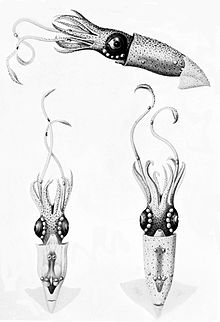Lycoteuthis lorigera
Appearance
| Lycoteuthis lorigera | |
|---|---|

| |
| Scientific classification | |
| Domain: | Eukaryota |
| Kingdom: | Animalia |
| Phylum: | Mollusca |
| Class: | Cephalopoda |
| Order: | Oegopsida |
| Family: | Lycoteuthidae |
| Genus: | Lycoteuthis |
| Species: | L. lorigera
|
| Binomial name | |
| Lycoteuthis lorigera Steenstrup, 1875[2]
| |
| Synonyms[3] | |
Lycoteuthis lorigera is a species of squid in the genus Lycoteuthis. They grow up to 8 cm (3.1 in) in length.[citation needed]
The Lycoteuthis lorigera males can grow from ranges between 136 mm to 194 mm. While females grow from ranges between 88 mm to 110 mm.[4] The Lycoteuthis lorigera males have paired spermatophoric and terminal organs. Both are functional.[5]
They use a serial spawning strategy, the spawning of several egg masses, which exposes eggs to variable environmental circumstances and increases the chance of encountering a beneficial regime for development. The number of ripe eggs in the oviducts suggests that batches of spawned egg masses contain between 1,000 and 4,000 eggs. [6]


References
[edit]- ^ Barratt, I.; Allcock, L. (2014). "Lycoteuthis lorigera". IUCN Red List of Threatened Species. 2014: e.T163008A963400. doi:10.2305/IUCN.UK.2014-1.RLTS.T163008A963400.en. Retrieved 18 November 2021.
- ^ Lycoteuthis lorigera - Hierarchy - The Taxonomicon
- ^ Julian Finn (2016). "Lycoteuthis lorigera (Steenstrup, 1875)". World Register of Marine Species. Flanders Marine Institute. Retrieved 7 March 2018.
- ^ Hoving (2007). "Growth and mating of southern African Lycoteuthis lorigera". Steenstrup. doi:10.1007/s11160-006-9031-9.
- ^ Hoving (2007). "Growth and mating of southern African Lycoteuthis lorigera". Steenstrup. doi:10.1007/s11160-006-9031-9.
- ^ Hoving (2014). "Fecundity, oogenesis, and ovulation pattern of southern African Lycoteuthis lorigera". Steenstrup. doi:10.1007/s10750-013-1586-6.

